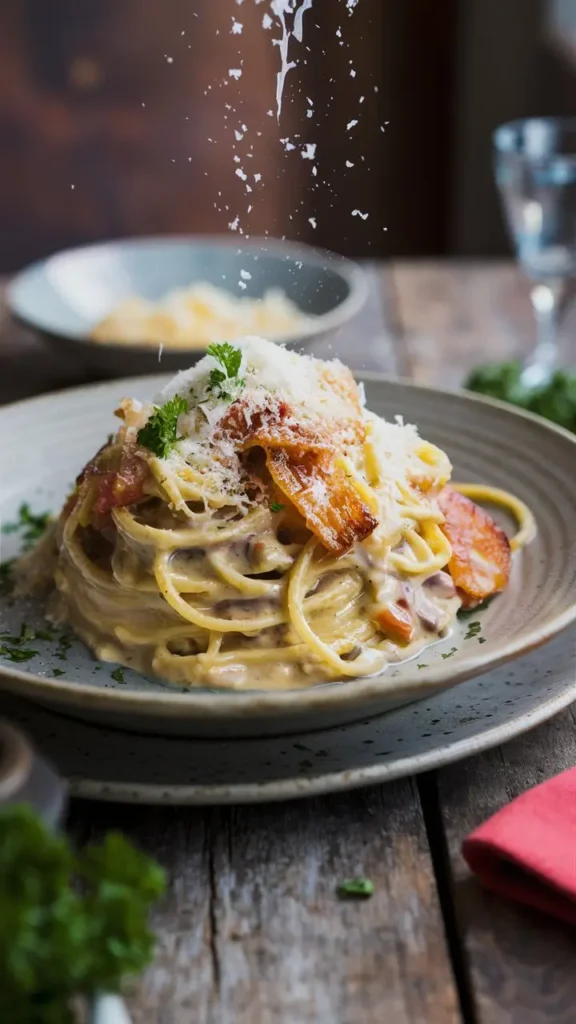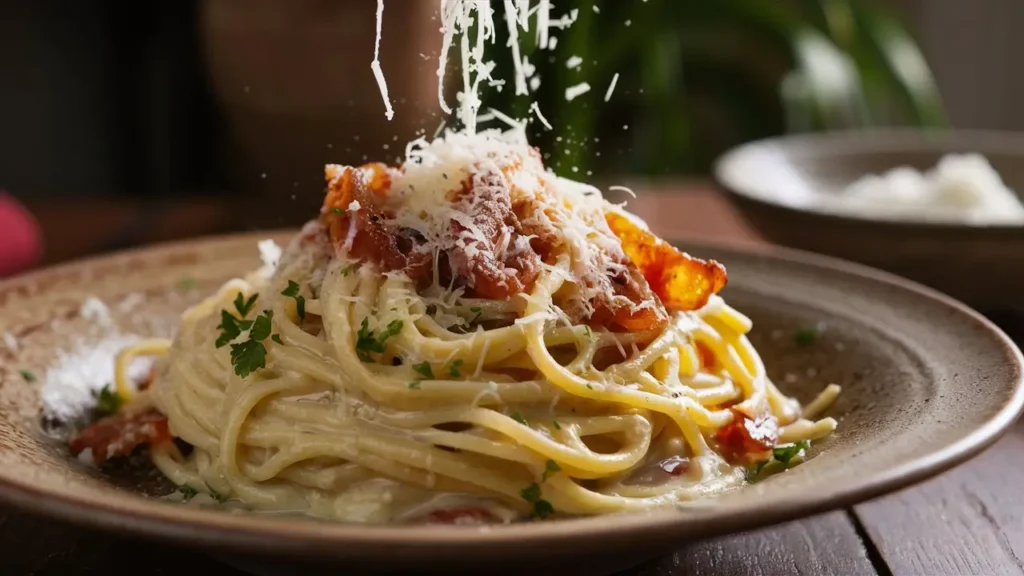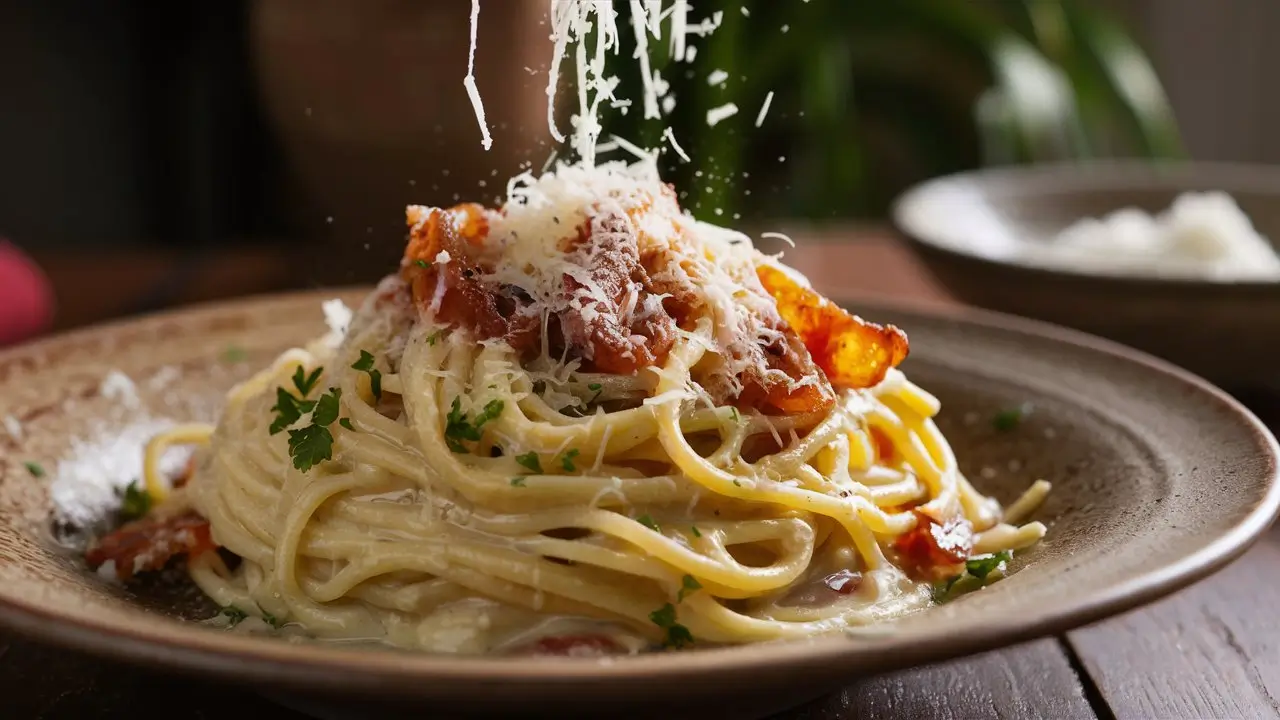Pasta Carbonara is one of the most beloved dishes in Italian cuisine. Creamy, savory, and comforting, this Roman classic is made with just a handful of simple ingredients—yet its flavor is remarkably rich and satisfying. Whether you’re preparing a weeknight dinner or impressing guests, Carbonara offers an authentic taste of Italy that’s easy to master at home.
What Is Pasta Carbonara?
Pasta Carbonara is a traditional Italian pasta dish made with eggs, cheese (typically Pecorino Romano), cured pork (usually guanciale), and freshly cracked black pepper. There is no cream in authentic Carbonara—the creamy texture comes entirely from the emulsion of eggs, cheese, and pasta water.

Ingredient List
Here’s what you need to serve 4 people:
-
12 oz (340 g) spaghetti or rigatoni
-
5 oz (140 g) guanciale, diced (or pancetta)
-
3 large egg yolks + 1 whole egg
-
1 cup (100 g) freshly grated Pecorino Romano
-
1 teaspoon freshly cracked black pepper
-
Salt (for boiling water)
Choosing the Right Pasta
Spaghetti
The most traditional pasta shape used in Carbonara. Its long strands coat well with the creamy sauce.
Rigatoni
Another excellent choice, especially for those who prefer a tubular pasta that holds onto bits of guanciale.
Bucatini
A thicker, hollow spaghetti that offers a slightly different texture and chew.
The Importance of Guanciale
Guanciale is an unsmoked Italian cured meat made from pork cheek or jowl. It has a rich, fatty flavor that is essential to a truly authentic Carbonara. If you can’t find guanciale, pancetta (Italian cured pork belly) is an acceptable substitute, though the flavor will be milder.
Avoid using American bacon—it’s smoked, which changes the flavor profile.
Timing & Servings
Prep Time: 10 minutes
Cook Time: 20 minutes
Total Time: 30 minutes
Servings: 4
Step-by-step sInstructions for Pasta Carbonara
Step 1: Boil the Pasta
Bring a large pot of salted water to a boil. Add pasta and cook until al dente according to the package instructions. Reserve at least 1 cup of the pasta water before draining.
Step 2: Cook the Guanciale
In a large skillet over medium heat, cook the diced guanciale until golden and crispy, about 5–7 minutes. Remove from heat and set aside, leaving the rendered fat in the pan.
Step 3: Prepare the Egg Mixture
In a mixing bowl, whisk together the egg yolks, whole egg, grated Pecorino Romano, and black pepper. Set aside.
Step 4: Combine Pasta and Guanciale
Return the cooked pasta to the skillet with the guanciale. Toss to coat in the fat. Let cool for about 30 seconds to avoid scrambling the eggs.
Step 5: Create the Sauce
Pour the egg and cheese mixture into the pasta, tossing vigorously to coat. Add a bit of reserved hot pasta water as needed to create a smooth, creamy sauce. Work quickly to ensure the eggs cook gently from the heat of the pasta without curdling.
Step 6: Serve
Serve immediately with extra Pecorino Romano and black pepper on top.

Tips for the Perfect Carbonara
Use Room-Temperature Eggs
This helps prevent the sauce from curdling when mixed with the pasta.
Work Quickly
Timing is crucial—mix the sauce while the pasta is hot, but not scorching.
Don’t Overdo the Salt
Guanciale and Pecorino are both salty, so go light on salting the pasta water.
Add Pasta Water Gradually
Too much can make the sauce runny. Add little by little until creamy.
Common Mistakes to Avoid
Adding Cream
True Carbonara doesn’t contain cream. The creamy texture should come from eggs and cheese.
Scrambling the Eggs
If the pasta is too hot when you add the eggs, they’ll cook too fast. Let the pasta cool slightly before mixing.
Skipping the Pasta Water
Pasta water is starchy and salty, helping to emulsify the sauce.
Carbonara Variations
While purists prefer the traditional method, there are some delicious adaptations you can explore.
Mushroom Carbonara
Add sautéed mushrooms for a meaty, earthy flavor.
Vegetarian Carbonara
Use smoked tofu or mushrooms in place of guanciale for a plant-based twist.
Carbonara with Peas
Some versions include green peas for a touch of sweetness and color.
Carbonara with Parmesan
If Pecorino is unavailable, Parmesan can be used as a milder alternative.
How to Reheat Carbonara
Carbonara is best enjoyed fresh, but you can reheat it gently on the stovetop.
-
Add a splash of milk or pasta water to loosen the sauce.
-
Warm over low heat while stirring constantly.
-
Avoid microwaving, which can overcook the eggs.
What to Serve with Pasta Carbonara
Carbonara is rich and satisfying, so pair it with lighter sides like:
-
Arugula salad with lemon vinaigrette
-
Roasted vegetables
-
Garlic bread
-
A glass of dry white wine (like Pinot Grigio)
Storage Tips
-
Refrigerator: Store leftovers in an airtight container for up to 2 days.
-
Freezer: Not recommended. The egg-based sauce doesn’t freeze well.
Nutritional Information (Per Serving)
-
Calories: ~550
-
Protein: 20–25g
-
Carbohydrates: 45–50g
-
Fat: 30–35g
-
Sodium: ~700mg
FAQs
Can I make Carbonara without pork?
Yes, try using mushrooms, smoked tofu, or a vegetarian bacon substitute.
Is Carbonara safe with raw eggs?
The residual heat from the pasta cooks the eggs just enough to be safe. Use fresh, high-quality eggs.
Can I use milk or cream?
Traditional Carbonara does not use dairy. Cream may make it heavier and dilute the authentic flavor.
Conclusion
Pasta Carbonara is proof that simple ingredients, when treated with care, can create extraordinary results. With its rich, creamy sauce and salty bits of pork, Carbonara is comforting, elegant, and deeply satisfying. Whether you stick with the traditional method or try a creative variation, this dish is sure to become a favorite in your recipe rotation.
